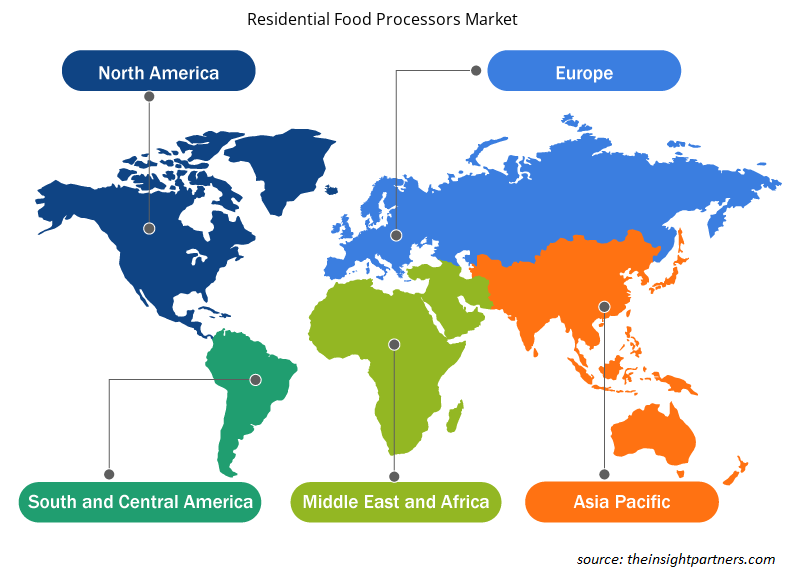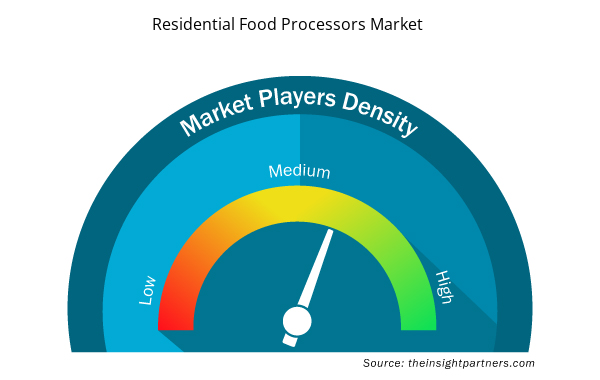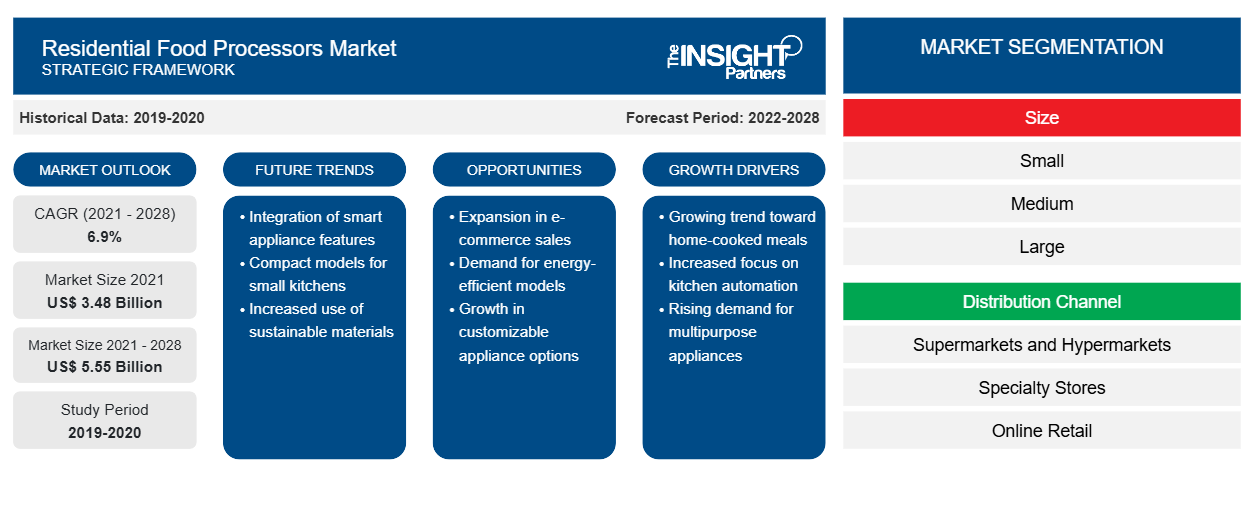Der Markt für Küchenmaschinen für den Privatgebrauch wurde im Jahr 2021 auf 3.475,21 Millionen US-Dollar geschätzt und soll bis 2028 einen Wert von 5.553,20 Millionen US-Dollar erreichen; von 2021 bis 2028 wird ein durchschnittliches jährliches Wachstum von 6,9 % erwartet.
Eine Haushalts-Küchenmaschine ist im Grunde ein Küchengerät, das zur Erleichterung sich wiederholender Aufgaben bei der Lebensmittelzubereitung verwendet wird. Die heutigen Küchenmaschinen sind meist automatisiert und erleichtern die Zubereitung von Speisen.
Im Jahr 2020 dominierte der asiatisch-pazifische Raum den globalen Markt für Haushaltsküchenmaschinen und wird seine Vormachtstellung im Prognosezeitraum voraussichtlich beibehalten. Der Anstieg der erwerbstätigen Bevölkerung in der gesamten Region hat zu einer steigenden Nachfrage nach praktischen Haushalts- und Küchengeräten geführt . Diese Faktoren dürften die Nachfrage nach Haushaltsküchenmaschinen in der gesamten Region ankurbeln. Darüber hinaus hat der veränderte Lebensstil der Verbraucher zu einer verstärkten Nutzung moderner Haushalts- und Küchengeräte geführt. Die steigende Bevölkerung in Ländern wie China und Indien hat zu einem verstärkten Bau von Wohnhäusern und -komplexen mit begrenztem Platz in der Küche geführt. Dies führte wiederum zu einer erhöhten Nachfrage nach kleinen Küchengeräten wie Mini-Küchenmaschinen.
Passen Sie diesen Bericht Ihren Anforderungen an
Sie erhalten kostenlos individuelle Anpassungen an jedem Bericht, einschließlich Teilen dieses Berichts oder einer Analyse auf Länderebene, eines Excel-Datenpakets sowie tolle Angebote und Rabatte für Start-ups und Universitäten.
- Holen Sie sich die wichtigsten Markttrends aus diesem Bericht.Dieses KOSTENLOSE Beispiel umfasst eine Datenanalyse von Markttrends bis hin zu Schätzungen und Prognosen.
Markteinblicke
Steigende Nachfrage nach praktischen Produkten
Der Lebensstil der Verbraucher ist in den letzten Jahren aufgrund des gestiegenen Arbeitsdrucks hektischer geworden, sodass sie sich nach ihren regulären Arbeitszeiten erschöpft fühlen. Berufstätige bevorzugen zunehmend praktische, automatisierte und intelligente Haushalts- und Küchengeräte, die ihnen Zeit und Mühe sparen. Die Küchenmaschinen für den Hausgebrauch sind multifunktional und schnell. Diese Küchenmaschinen arbeiten effektiv und erleichtern den Kochvorgang erheblich, selbst wenn ein Benutzer für eine große Anzahl von Personen kocht.
Größeninformationen
Basierend auf der Größe ist der Markt für Haushaltsküchenmaschinen in klein, mittel und groß unterteilt. Im Jahr 2020 dominierte das mittlere Segment den Markt. Die zunehmende Einschränkung von Küchengröße und -raum in Entwicklungsländern ist einer der Faktoren, die die Nachfrage nach mittelgroßen Haushaltsküchenmaschinen antreiben. Die mittelgroße Haushaltsküchenmaschine umfasst eine mittelgroße Schneidscheibe, eine Raspelscheibe und ein Edelstahl-Hackmesser zum Verarbeiten.
Koninklijke Philips NV , Whirlpool Corporation, Breville Group Limited, De'Longhi Appliances Srl , Conair Corporation, Robert Bosch GmbH , MAGIMIX , SharkNinja Operating LLC , Groupe SEB und Spectrum Brands Inc. gehören zu den wichtigsten Akteuren auf dem Markt für Haushaltsküchenmaschinen. Die führenden Akteure verfolgen verschiedene Strategien, wie Fusionen und Übernahmen sowie Produkteinführungen, um ihre geografische Präsenz und Kundenbasis zu erweitern.
Regionale Einblicke in den Markt für Haushaltsküchenmaschinen
Die regionalen Trends und Faktoren, die den Markt für Haushaltsküchenmaschinen im Prognosezeitraum beeinflussen, wurden von den Analysten von Insight Partners ausführlich erläutert. In diesem Abschnitt werden auch die Marktsegmente und die Geografie von Haushaltsküchenmaschinen in Nordamerika, Europa, im asiatisch-pazifischen Raum, im Nahen Osten und Afrika sowie in Süd- und Mittelamerika erörtert.

- Erhalten Sie regionale Daten zum Markt für Haushalts-Küchenmaschinen
Umfang des Marktberichts über Küchenmaschinen für Privathaushalte
| Berichtsattribut | Details |
|---|---|
| Marktgröße im Jahr 2021 | 3,48 Milliarden US-Dollar |
| Marktgröße bis 2028 | 5,55 Milliarden US-Dollar |
| Globale CAGR (2021 - 2028) | 6,9 % |
| Historische Daten | 2019-2020 |
| Prognosezeitraum | 2022–2028 |
| Abgedeckte Segmente | Nach Größe
|
| Abgedeckte Regionen und Länder | Nordamerika
|
| Marktführer und wichtige Unternehmensprofile |
|
Marktteilnehmerdichte für Haushalts-Küchenmaschinen: Auswirkungen auf die Geschäftsdynamik verstehen
Der Markt für Haushalts-Küchenmaschinen wächst rasant, angetrieben durch die steigende Nachfrage der Endverbraucher aufgrund von Faktoren wie sich entwickelnden Verbraucherpräferenzen, technologischen Fortschritten und einem größeren Bewusstsein für die Vorteile des Produkts. Mit steigender Nachfrage erweitern Unternehmen ihr Angebot, entwickeln Innovationen, um die Bedürfnisse der Verbraucher zu erfüllen, und nutzen neue Trends, was das Marktwachstum weiter ankurbelt.
Die Marktteilnehmerdichte bezieht sich auf die Verteilung der Firmen oder Unternehmen, die in einem bestimmten Markt oder einer bestimmten Branche tätig sind. Sie gibt an, wie viele Wettbewerber (Marktteilnehmer) in einem bestimmten Marktraum im Verhältnis zu seiner Größe oder seinem gesamten Marktwert präsent sind.
Die wichtigsten Unternehmen auf dem Markt für Küchenmaschinen für den Privatgebrauch sind:
- Koninklijke Philips NV Philips N.V.
- Whirlpool Corporation
- Breville Gruppe Limited Group Limited
- De
Haftungsausschluss : Die oben aufgeführten Unternehmen sind nicht in einer bestimmten Reihenfolge aufgeführt.

- Überblick über die wichtigsten Akteure auf dem Markt für Haushalts-Küchenmaschinen
Bericht-Spotlights
- Progressive Trends in der Branche der Haushaltsküchenmaschinen helfen den Akteuren bei der Entwicklung wirksamer langfristiger Strategien
- Von Unternehmen verfolgte Geschäftswachstumsstrategien zur Sicherung des Wachstums in entwickelten und sich entwickelnden Märkten
- Quantitative Analyse des globalen Marktes für Haushaltsküchenmaschinen von 2019 bis 2028
- Schätzung der Nachfrage nach Küchenmaschinen für den Privatgebrauch in verschiedenen Branchen
- PEST-Analyse zur Veranschaulichung der Wirksamkeit der in der Branche tätigen Käufer und Lieferanten bei der Vorhersage des Marktwachstums
- Aktuelle Entwicklungen zum Verständnis des Wettbewerbsmarktszenarios und der Nachfrage nach Haushalts-Küchenmaschinen
- Markttrends und -aussichten in Verbindung mit Faktoren, die das Wachstum des Marktes für Haushaltsküchenmaschinen vorantreiben und bremsen
- Verständnis der Strategien, die dem kommerziellen Interesse im Hinblick auf das Wachstum des globalen Marktes für Haushaltsküchenmaschinen zugrunde liegen, und Unterstützung des Entscheidungsprozesses
- Marktgröße für Haushalts-Küchenmaschinen an verschiedenen Marktknoten
- Detaillierte Übersicht und Segmentierung des globalen Marktes für Haushaltsküchenmaschinen sowie seiner Branchendynamik
- Marktgröße für Haushaltsküchenmaschinen in verschiedenen Regionen mit vielversprechenden Wachstumschancen
Die „Globale Marktanalyse für Haushaltsküchenmaschinen bis 2028“ ist eine spezialisierte und eingehende Studie der Konsumgüterindustrie mit besonderem Schwerpunkt auf der globalen Trendanalyse des Marktes für Haushaltsküchenmaschinen. Der Bericht soll einen Überblick über den Markt mit detaillierter Marktsegmentierung bieten. Der Markt für Haushaltsküchenmaschinen ist nach Größe, Vertriebskanal und Geografie segmentiert. Basierend auf der Größe ist der Markt in klein, mittel und groß segmentiert. Basierend auf dem Vertriebskanal ist der Markt für Haushaltsküchenmaschinen in Supermärkte und Hypermärkte, Fachgeschäfte, Online-Einzelhandel und andere segmentiert. Basierend auf der Geografie ist der Markt in fünf Hauptregionen segmentiert – Nordamerika, Europa, Asien-Pazifik, Naher Osten und Afrika sowie Süd- und Mittelamerika.
Firmenprofile
- Koninklijke Philips NV Philips N.V.
- Whirlpool Corporation
- Breville Gruppe Limited Group Limited
- De'Longhi Appliances Srl Appliances S.r.l.
- Conair Corporation Corporation
- Robert Bosch GmbHGmbH
- MAGIMIX
- SharkNinja Operating LLC Operating LLC
- Gruppe SEB SEB
- Spectrum Brands Inc.
- Historische Analyse (2 Jahre), Basisjahr, Prognose (7 Jahre) mit CAGR
- PEST- und SWOT-Analyse
- Marktgröße Wert/Volumen – Global, Regional, Land
- Branche und Wettbewerbsumfeld
- Excel-Datensatz


- Transdermal Drug Delivery System Market
- Sexual Wellness Market
- Non-Emergency Medical Transportation Market
- Rugged Phones Market
- Fertilizer Additives Market
- Authentication and Brand Protection Market
- Fishing Equipment Market
- High Speed Cable Market
- Smart Locks Market
- Real-Time Location Systems Market

Report Coverage
Revenue forecast, Company Analysis, Industry landscape, Growth factors, and Trends

Segment Covered
This text is related
to segments covered.

Regional Scope
North America, Europe, Asia Pacific, Middle East & Africa, South & Central America

Country Scope
This text is related
to country scope.
Häufig gestellte Fragen
Asia Pacific is expected to be the fastest growing region within the global residential food processors market. The rising population in countries such as China and India have led to an increase in the construction of residential houses and complexes having limited kitchen space. Thus, there is an increased demand for multifunctional and small kitchen appliances. Thus, mini residential food processor is preferred in such countries in terms of convenience because they are lightweight, multifunctional and require little space. Thus, the rapidly changing lifestyle of consumers, increasing awareness related to eco-friendly products, and the rising trend of automation in day-to-day activities to save time are providing lucrative opportunities for the residential food processors market in Asia-Pacific.
In 2020, specialty stores held the largest market share in the global residential food processors market. Specialty stores focus on the specific product category and have wide product varieties. The stores provide a personalized shopping experience and a positive retail environment to the customers. They offer value-added products to their customers and focus on customer satisfaction. Moreover, specialty stores usually have trained staff who can assist the customers in making the purchase decisions. For the residential food processors market, specialty stores are expected to maintain their market prominence amongst other distribution channels due to the availability of specific products under one roof, pleasant atmosphere of store, and the presence of skilled staff that can help the customer choose the right product.
In 2020, the medium-size segment accounted for the largest market share. Medium-size residential food processors have a capacity of 9 to 12 cups and are great for making four portions of food at a time. It is suitable for chopping, dicing, mincing, and slicing. It is used for shredding hard cheeses, carrots, sprouts, and potatoes and pureeing soups, sauces, desserts, and dips. These food processors are also available with the multi-purpose dough blade and reversible slicing or shredding disc for preparing a variety of shapes and sizes ideal for recipes.
On the basis of distribution channels, online retail is the fastest-growing segment. Ecommerce platforms offer many products of various categories to customers across the world. Consumers can buy any product online from their homes or offices. Online retail is the fastest-growing distribution channel for the residential food processors market owing to many factors, such as ease of accessibility, availability of a wide range of products, cashback, discount coupons, and attractive deals. Aided by the disruption of physical stores due to the Covid-19 pandemic and lockdowns, the market for the online retail segment is expected to grow rapidly in the next few years.
The major players operating in the global residential food processors market are Koninklijke Philips N.V.; Whirlpool Corporation; Breville Group Limited; De’Longhi Appliances S.r.l.; Conair Corporation; Robert Bosch GmbH; MAGIMIX; SharkNinja Operating LLC; Groupe SEB; and Spectrum Brands Inc.
In 2020, Asia Pacific accounted for the largest share of the global residential food processors market. The countries in the region, such as China, India, and South Korea, are witnessing an upsurge in the middle-class population and growth in urbanization. The changing lifestyle of the consumers and increasing working population are propelling the adoption of modernized household and kitchen appliances.
Trends and growth analysis reports related to Consumer Goods : READ MORE..
The List of Companies - Residential Food Processors Market
- Koninklijke Philips N.V.
- Whirlpool Corporation
- Breville Group Limited
- De’Longhi Appliances S.r.l.
- Conair Corporation
- Robert Bosch GmbH
- MAGIMIX
- SharkNinja Operating LLC
- Groupe SEB
- Spectrum Brands, Inc
The Insight Partners performs research in 4 major stages: Data Collection & Secondary Research, Primary Research, Data Analysis and Data Triangulation & Final Review.
- Data Collection and Secondary Research:
As a market research and consulting firm operating from a decade, we have published and advised several client across the globe. First step for any study will start with an assessment of currently available data and insights from existing reports. Further, historical and current market information is collected from Investor Presentations, Annual Reports, SEC Filings, etc., and other information related to company’s performance and market positioning are gathered from Paid Databases (Factiva, Hoovers, and Reuters) and various other publications available in public domain.
Several associations trade associates, technical forums, institutes, societies and organization are accessed to gain technical as well as market related insights through their publications such as research papers, blogs and press releases related to the studies are referred to get cues about the market. Further, white papers, journals, magazines, and other news articles published in last 3 years are scrutinized and analyzed to understand the current market trends.
- Primary Research:
The primarily interview analysis comprise of data obtained from industry participants interview and answers to survey questions gathered by in-house primary team.
For primary research, interviews are conducted with industry experts/CEOs/Marketing Managers/VPs/Subject Matter Experts from both demand and supply side to get a 360-degree view of the market. The primary team conducts several interviews based on the complexity of the markets to understand the various market trends and dynamics which makes research more credible and precise.
A typical research interview fulfils the following functions:
- Provides first-hand information on the market size, market trends, growth trends, competitive landscape, and outlook
- Validates and strengthens in-house secondary research findings
- Develops the analysis team’s expertise and market understanding
Primary research involves email interactions and telephone interviews for each market, category, segment, and sub-segment across geographies. The participants who typically take part in such a process include, but are not limited to:
- Industry participants: VPs, business development managers, market intelligence managers and national sales managers
- Outside experts: Valuation experts, research analysts and key opinion leaders specializing in the electronics and semiconductor industry.
Below is the breakup of our primary respondents by company, designation, and region:

Once we receive the confirmation from primary research sources or primary respondents, we finalize the base year market estimation and forecast the data as per the macroeconomic and microeconomic factors assessed during data collection.
- Data Analysis:
Once data is validated through both secondary as well as primary respondents, we finalize the market estimations by hypothesis formulation and factor analysis at regional and country level.
- Macro-Economic Factor Analysis:
We analyse macroeconomic indicators such the gross domestic product (GDP), increase in the demand for goods and services across industries, technological advancement, regional economic growth, governmental policies, the influence of COVID-19, PEST analysis, and other aspects. This analysis aids in setting benchmarks for various nations/regions and approximating market splits. Additionally, the general trend of the aforementioned components aid in determining the market's development possibilities.
- Country Level Data:
Various factors that are especially aligned to the country are taken into account to determine the market size for a certain area and country, including the presence of vendors, such as headquarters and offices, the country's GDP, demand patterns, and industry growth. To comprehend the market dynamics for the nation, a number of growth variables, inhibitors, application areas, and current market trends are researched. The aforementioned elements aid in determining the country's overall market's growth potential.
- Company Profile:
The “Table of Contents” is formulated by listing and analyzing more than 25 - 30 companies operating in the market ecosystem across geographies. However, we profile only 10 companies as a standard practice in our syndicate reports. These 10 companies comprise leading, emerging, and regional players. Nonetheless, our analysis is not restricted to the 10 listed companies, we also analyze other companies present in the market to develop a holistic view and understand the prevailing trends. The “Company Profiles” section in the report covers key facts, business description, products & services, financial information, SWOT analysis, and key developments. The financial information presented is extracted from the annual reports and official documents of the publicly listed companies. Upon collecting the information for the sections of respective companies, we verify them via various primary sources and then compile the data in respective company profiles. The company level information helps us in deriving the base number as well as in forecasting the market size.
- Developing Base Number:
Aggregation of sales statistics (2020-2022) and macro-economic factor, and other secondary and primary research insights are utilized to arrive at base number and related market shares for 2022. The data gaps are identified in this step and relevant market data is analyzed, collected from paid primary interviews or databases. On finalizing the base year market size, forecasts are developed on the basis of macro-economic, industry and market growth factors and company level analysis.
- Data Triangulation and Final Review:
The market findings and base year market size calculations are validated from supply as well as demand side. Demand side validations are based on macro-economic factor analysis and benchmarks for respective regions and countries. In case of supply side validations, revenues of major companies are estimated (in case not available) based on industry benchmark, approximate number of employees, product portfolio, and primary interviews revenues are gathered. Further revenue from target product/service segment is assessed to avoid overshooting of market statistics. In case of heavy deviations between supply and demand side values, all thes steps are repeated to achieve synchronization.
We follow an iterative model, wherein we share our research findings with Subject Matter Experts (SME’s) and Key Opinion Leaders (KOLs) until consensus view of the market is not formulated – this model negates any drastic deviation in the opinions of experts. Only validated and universally acceptable research findings are quoted in our reports.
We have important check points that we use to validate our research findings – which we call – data triangulation, where we validate the information, we generate from secondary sources with primary interviews and then we re-validate with our internal data bases and Subject matter experts. This comprehensive model enables us to deliver high quality, reliable data in shortest possible time.


 Holen Sie sich ein kostenloses Muster für diesen Bericht
Holen Sie sich ein kostenloses Muster für diesen Bericht